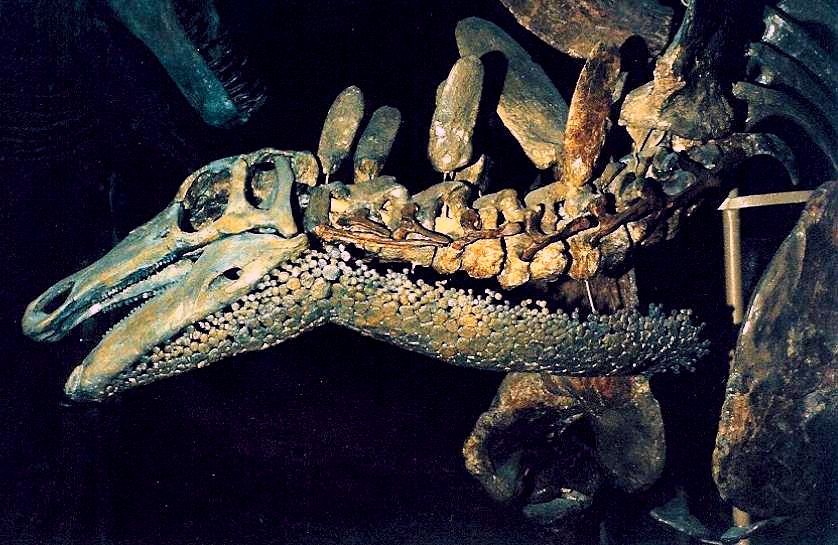 |
| Ahhh, Stegosaurus neck armor, all the things you can tell us.... |
Being the Paleontologist-in-training that I am, I'm very interested in how dinosaurs behaved and interacted with one another on a daily basis. I want to know how they caught their prey, escaped from predators, and what they were doing that helped them survive for however long they did, and much of a dinosaur's anatomy can tell you exactly that. I've developed a little talent where I can look at any part of a dinosaur's anatomy and come up with a number of ideas for the purpose of the limb, neck, tail, or skull. Then it can give me some ideas on how the animal might have lived.
For example, Stegosaurus is famous for its double row of back plates on its back, but many people don't know that it actually had a dense layer of pebbly armor on the underside of its neck. The most obvious idea is that the neck armor was a defence for the neck against theropods, but I can think of many more functions. Another is that the armor could have been used as a display, similar to what many now think the plate's function was. Some pebbly osteoderms seen in things like iguanas and other lizards are used as a form of display, and large scales seen around the head region in both lizards and birds are used for show.
Stegosaurus also notably lived in an environment filled with cycads, which produce large cones filled with seeds that are very nutritious. However, the cone is protected by the large spiny leaves surrounding the center of the plant, and could cause injury to animals trying to reach into it. So maybe the neck armor was used to help Stegosaurus reach into the cycads and feed on the seeds. Maybe Stegosaurus was a specialist cycad eater?!
Entire debates can spur up from little ideas like this, and can help explain many unexplained phenomena in the fossil record. Stegosaurs became less common by the beginning of the Cretaceous, but flowering plants also started to take over by this time as well. The evolution of flowering plants also coincided with the diversification of numerous groups of herbivores, among them the ornithopods and ankylosaurs, which would've caused competition with the Stegosaurs. Angiosperms also began out-competing cycads and forcing them to retreat to the tropics, so perhaps the cycad-eating stegosaurs went extinct as the cycads sterted to disapear. It could have happened.
(I literally came up with that theory within the last 20 minutes before writing this, but looking over it multiple times I can believe it. I'll probably look more into the idea, see if anyone else has suggested anything like it....)
I can do the same thing with other dinosaurs, take this for example: Small ornithopods like Hypsilophodon have long toes. It's true, Hypsilophodon and its relatives do have rather long toes. At first some thought this meant they may have been tree-climbers, a lot like tree kangaroos from Australia and New Guinea, which also have long toes. However, many now find this unlikely, since many of the proportions of the feet are not like those of tree-climbing animals, and are typical of ground-dwelling ones. They also had stiffened tails, not the flexible tails of most tree-dwelling animals, and suggest that they were fast runners. So why did they have long toes?
Looking at modern animals, many ground-dwelling animals that have long toes live on marshy and uneven ground, since it gives them more grip when moving and helps prevent them from sinking in mud. Many of these species are also found in deposits that were marshy and wet at the time, and it seems likely to think that they were living in these environments. Even if many people agree that it had a certain function, opinions on how it was used may still differ. Camels, for example, also have long toes and broad feet to gain the same effect when moving across sand dunes. So maybe they were desert dwellers? (I find this unlikely) Some small animals also use long toes to help distribute weight while moving over snow, very similar to what snowshoes tend to do. Some small ornithopods like Leaellynasaura would've encountered snow during parts of the year, so perhaps their long toes helped them with moving across this kind of terrain.
As you can see, you can tell a bunch of stuff by just looking at a dinosaur's foot, tail, or skull, and little details like what I listed before can tell you all kinds of things about how it survived, interacted, and even went extinct. That's why every bone counts when talking about dinosaurs. So, I've decided that the next few posts I make are going to be about all kinds of interesting dinosaurs. I'm also thinking about making some topics about different dinosaur lifestyles, such as semi-aquatic ones, and different behaviors the would've exploited. Many people only think of spinosaurs when talking about semi-aquatic dinosaurs, but trust me, I've found many more examples than those fish-eating theropods.
So yea, you could say this is my make-up for the previous month of absence, but I was planing on doing this before then anyways. So, as always, I'll take requests for dinosaurs and as many ideas for topics as wanted.
RaptorX
So yea, you could say this is my make-up for the previous month of absence, but I was planing on doing this before then anyways. So, as always, I'll take requests for dinosaurs and as many ideas for topics as wanted.
RaptorX
No comments:
Post a Comment